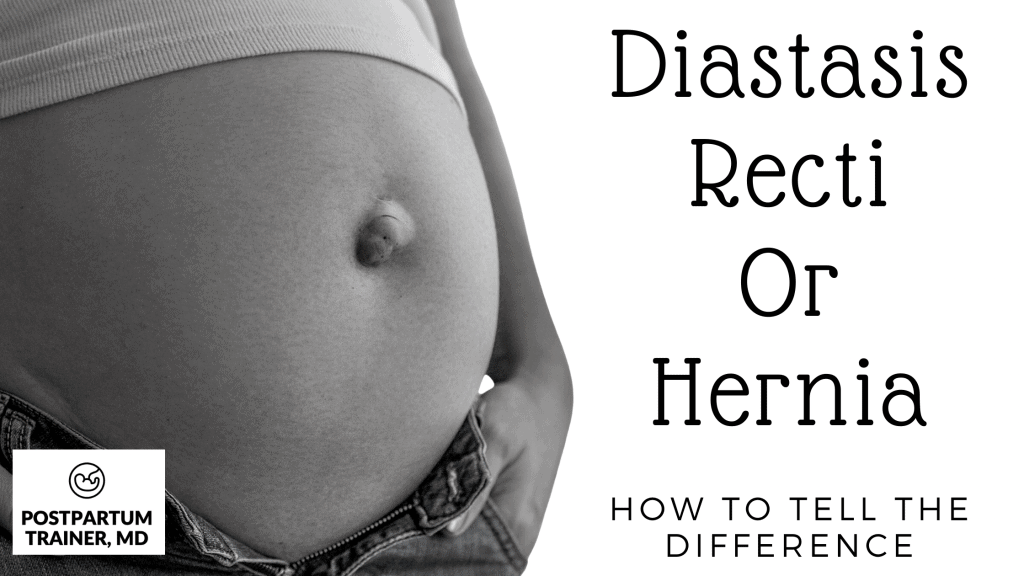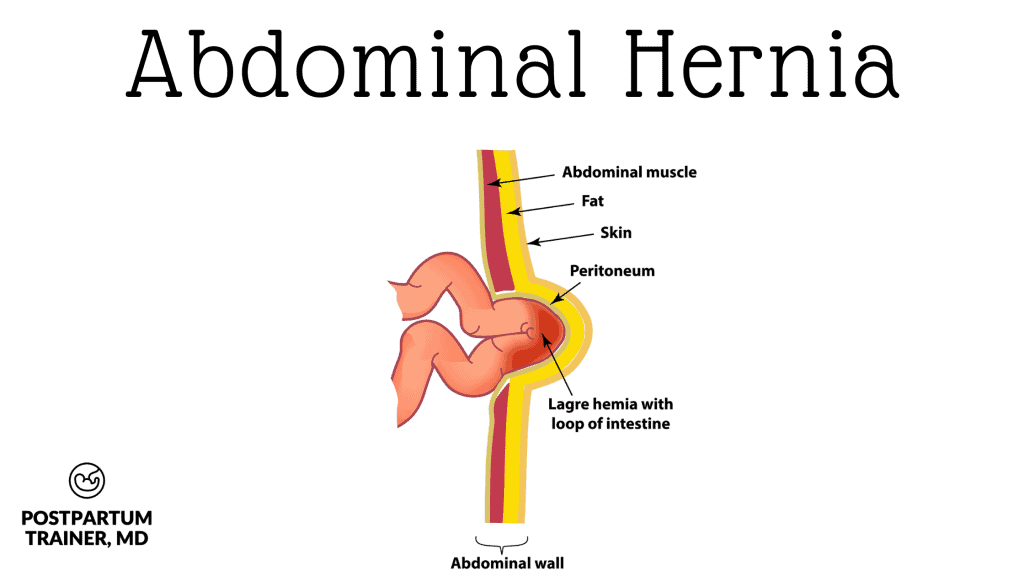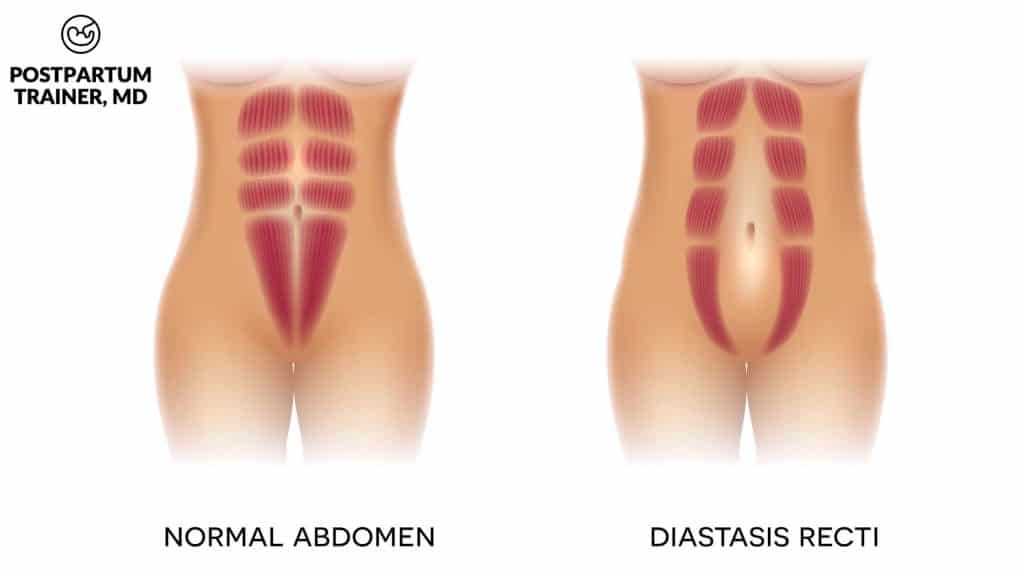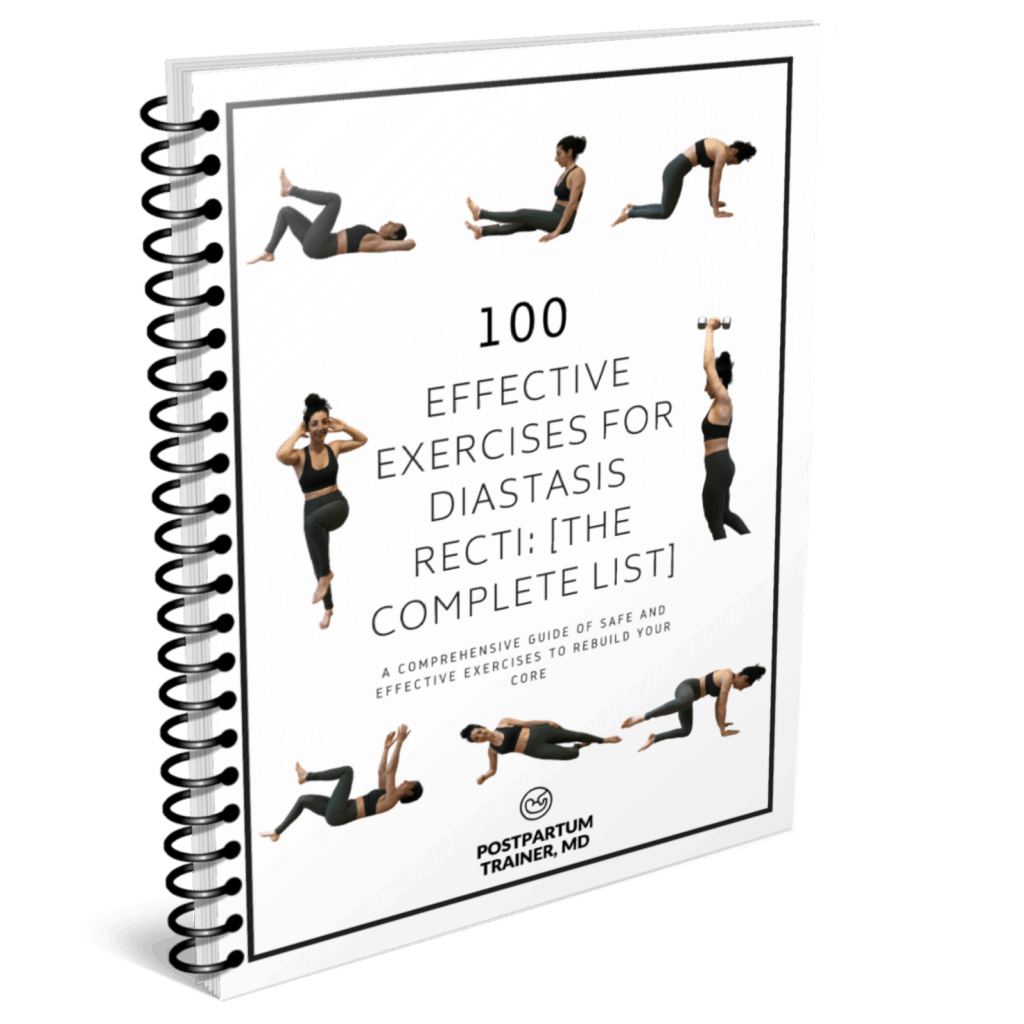Do you feel a bulge in your belly and are unsure if you have diastasis recti or a hernia?
In short, diastasis recti is a separation of your abdominal muscles whereas a hernia is a protrusion of an organ.
In this post, I will explain:
- how to tell if you have diastasis recti,
- how to tell if you have a hernia, and
- what your treatment options are.
Let’s get started.

Do you have Diastasis Recti or a hernia?
Diastasis recti occurs when your abdominal muscles separate along the midline. A hernia occurs when an organ or tissue protrudes through a defect or hole in one of the tissue layers of your abdominal wall.
However, it is possible to have both. If an abdominal organ protrudes from your diastasis abdominal separation, you also have a hernia.
How do you Know If You Have A hernia From Pregnancy?
Your belly button is one of the most common places for a ventral hernia, also known as an umbilical hernia.
If you notice a bulge around your belly button, especially when increasing your abdominal pressure, you may have a postpartum umbilical hernia.
You may not see the hernia bulge at all times. It all depends on how big the defect is in your abdominal wall and how much tissue is protruding through it.
If you believe you have an abdominal hernia you should make an appointment with your physician.
I don’t recommend checking for a hernia at home in case you have a loop of bowel that is trapped in the defect.
Your physician will perform a physical examination in which she/he will palpate the area and possibly order an imaging study like an ultrasound, CT scan of your abdomen, or MRI of your abdomen.
Do you always get a bulge with a hernia?
You may or may not have a bulge present at all times when you have an abdominal hernia.
If the defect is small, you might not have a significant amount of tissue protruding through it.
Any bulge can be worsened with any of the following activities:
- lifting heavy objects
- straining on the toilet
- coughing or vomiting
- performing sit-ups or crunches, and
- lying down
What Are The Symptoms Of A Hernia after pregnancy?
The most common symptoms of an abdominal hernia after pregnancy include:
- a protruding belly button
- mild pain in your abdomen
- pressure
- bloating
- pain that worsens with an activity that increases your intra-abdominal pressure
- nausea
However, a small umbilical hernia might not cause any symptoms at all.

It’s also important to note that there are many different types of hernias you can get, such as:
- An epigastric hernia (above your belly button)
- An inguinal hernia (in your groin area / lower abdomen)
- An incisional hernia (if you had a c-section) and even
- A femoral hernia (near your upper inner thigh)
They can all present with similar symptoms. The only difference is the location.
What does a hernia feel like after pregnancy? is it hard or soft?
Abdominal hernias are usually soft and squishy, and that’s because the most common thing to protrude from them is the bowel.
Your small bowel is very soft and malleable.
Does a hernia hurt all the time?
An abdominal hernia should not hurt all the time.
The hernia can cause discomfort when performing things that increase intrabdominal pressure, such as heavy weightlifting, coughing, sneezing, and laughing.
If you experience severe pain with a known hernia diagnosis, you should seek immediate medical attention to rule out any emergency.
Unfortunately, the bowel inside the hernia can get stuck in your abdominal wall and become incarcerated.
The risk with incarcerated bowel is that they can pinch off their own blood supply causing strangulation.
Strangulation requires emergency surgery and can result in needing to have a portion of your bowel removed.
What Treatment Options Are there for a hernia?
Treatment for hernias is surgical – especially if you are symptomatic.
The good news is, a hernia repair can often be done via laparoscopic surgery.
With that said, there are a few non-surgical things you can do to try and prevent hernias from getting worse.
NOTE: THIS IS ONLY IF YOU ARE ASYMPTOMATIC.
These include:
- consuming a fiber-rich diet to help prevent straining on the toilet
- drinking 6-8 tall glasses of water every day
- avoiding heavy lifting, and
- avoiding sit-ups and crunches
You should always follow up closely with your doctor if you are diagnosed with a hernia.
They will be able to give you more information on whether you are a candidate for surgery depending on the size and symptomatology.
What happens if a hernia is left untreated?
If a hernia goes untreated, it might become bigger, cause worsening pain, and increase the likelihood of bowel incarceration and strangulation, a medical emergency requiring immediate surgery.
Treatment depends on the size of the hernia. A small hernia might not require any treatment.
Now let’s switch gears and talk about rectus diastasis quickly.
What Causes Diastasis?
Diastasis recti is due to a weakening of the connective tissue (known as the linea alba) that sits in between your rectus muscles.

During pregnancy, the growing uterus places a lot of pressure on your abdominal wall. This pressure results in a stretching of your abdomen’s connective tissues, leading to weakness and separation of the rectus abdominis muscle.
Research shows that almost 2/3rds of all postpartum women develop the condition.
What does Diastasis recti feel like?
Diastasis recti feels like a physical separation in the middle of your abdomen.
You may also feel like you have a flabby or weak stomach as your rectus muscle or “6 pack” muscles are stretched apart.
How to tell if you have Diastasis recti
To tell if you have diastasis recti you could get into a modified curl-up position.
Here is what it looks like:

To check if you have diastasis recti:
- Lie down on your back with your knees bent and your feet flat on the floor.
- Using one hand, place your fingers right above your belly button. (Depending on the separation you may need 1 or more fingers.)
- Now, lift your head off the floor as if you were getting into a crunch position. Be sure not to lift your shoulders off the floor.
If you feel the gap widening, you have diastasis recti.
I explain how to interpret the results and other ways of testing yourself in this post: How to tell if you have diastasis recti.
Keep in mind that the amount of abdominal wall separation does not always correlate with symptoms.
Can Diastasis Recti cause A hernia?
Diastasis recti can cause a hernia as there is an intrinsic weakness of the connective tissue that keeps your abdominal organs in place.
If you have a large enough defect and increase your intrabdominal pressure significantly, your small intestines or omentum can potentially poke out.
What Treatment options are there for Diastasis recti?
You may not know that in some cases, diastasis recti can get better on its own.
One study showed that more than half of postpartum women had resolution of their diastasis recti by 6 months.
With that said, every postpartum woman should strengthen their core as pregnancy always leads to a weakening of her abdominal muscles.
However, you must be careful with the exercises you do, and only perform ones that don’t worsen your diastasis.
AVOID any abdominal exercise that causes pain or worsens the diastasis recti.
I have a Safe Diastasis Recti Exercise Program for New Moms that you can do at home to get started.
100 Diastasis Recti Exercises
I have created a comprehensive list of 100 exercises you could perform in the postpartum period to strengthen and rebuild your core muscles if you suffer from diastasis recti.
There are four levels starting at a beginner and progressing to an advanced level incorporating exercises where you are lying on your back, on your side, sitting up, and standing.
For more information, feel free to check it out below.
100 Exercises For Diastasis Recti: The Complete List
When Should You Consider Diastasis Recti Surgery?
You can consider surgical repair of DR if:
- you have lowered your body fat levels to a healthy range,
- you have engaged in an exercise routine to strengthen your core, and
- more than 6-12 months have gone by and you do not notice any improvement in your symptoms
The type of surgery that is performed is called an abdominoplasty (aka tummy tuck).
A plastic surgeon does this surgery.
Be sure to speak with your provider and do your research to see if you are a good candidate for surgery, as no surgery is without risks.
What happens if DR is Left Untreated?
If diastasis recti goes untreated, you may experience lower back pain, pelvic floor dysfunction, and postural changes due to a weakened core.
Other Related Questions
Are hernias after pregnancy common?
Hernias are not very common after pregnancy. According to the latest research, postpartum hernia occur in less than 0.1% of women. However, some hernias are very small and may go undetected.
Can hernia go away on its own?
Unfortunately, a hernia does not go away on its own. The only way to treat a hernia is through surgical treatment by a general surgeon.
Your surgeon may place a piece of mesh to cover the defect or weak spot to prevent organs from protruding out.
Can you get a hernia after a c-section?
It is possible to get a hernia after a c-section delivery. You can get a ventral hernia (at your navel) or an incisional hernia (at the c-section surgical scar).
What is the recovery time after surgical intervention?
In general, most patients are able to go home on the same day of their hernia surgery.
However, it is important that you follow your surgeon’s post-operative instructions closely to avoid any complications and hernia recurrence.
Final Words on the difference between Diastasis Recti & Hernia
If you think you have an abdominal hernia or diastasis recti, make sure you speak with your provider as every case is different.
Depending on the type of hernia you have, you may or may not need surgical treatment.
Now I want to hear from you.
Did you suffer from diastasis recti or hernia after pregnancy?
What has helped you the most?
Comment below and let me know!
Related Articles
- Coning In Pregnancy [What Is It]
- How To Prevent Diastasis Recti [In Pregnancy & Beyond]
- How Long Does It Take To Heal Diastasis Recti [The Honest Truth]
- Diastasis Recti After A C-Section: [What You Need To Know]
Get Four Free Workouts To Help Strengthen Your Pelvic Floor & Heal Your Mommy Tummy!

Brittany Robles, MD, MPH, CPT
Brittany Robles is a full-time OBGYN physician, a NASM certified trainer, and a prenatal and postnatal fitness specialist. She holds a Master of Public Health degree in maternal health with a special interest in exercise and nutrition. She is also the co-author of The White Coat Trainer. Learn more about her here.
Sharing is Caring – Send This To A Mom In Need!
References:
- Dabbas N, Adams K, Pearson K, Royle G. Frequency of abdominal wall hernias: is classical teaching out of date?. JRSM Short Rep. 2011;2(1):5. Published 2011 Jan 19. doi:10.1258/shorts.2010.010071
- InformedHealth.org [Internet]. Cologne, Germany: Institute for Quality and Efficiency in Health Care (IQWiG); 2006-. Hernias: Overview. 2016 Sep 21 [Updated 2020 Jan 30]. Available from: https://www.ncbi.nlm.nih.gov/books/NBK395554/
- Sperstad JB, Tennfjord MK, Hilde G, et alDiastasis recti abdominis during pregnancy and 12 months after childbirth: prevalence, risk factors and report of lumbopelvic painBritish Journal of Sports Medicine 2016;50:1092-1096.
- Ranney B. Diastasis recti and umbilical hernia causes, recognition and repair. S D J Med. 1990 Oct;43(10):5-8. PMID: 2149203.
- Fernandes da Mota PG, Pascoal AG, Carita AI, Bø K. Prevalence and risk factors of diastasis recti abdominis from late pregnancy to 6 months postpartum, and relationship with lumbo-pelvic pain. Man Ther. 2015 Feb;20(1):200-5. doi: 10.1016/j.math.2014.09.002. Epub 2014 Sep 19. PMID: 25282439.
- Kulacoglu H. (2018). Umbilical Hernia Repair and Pregnancy: Before, during, after…. Frontiers in surgery, 5, 1. https://doi.org/10.3389/fsurg.2018.00001


I have both and my Doctor is concerned because i’m now getting pain in my stomach, iv’e seen to general surgeons and they’re only wanting to fix the Hernia, my Doctor is getting quite frustrated as the seperation is 4 fingers wide. Do you have any advice please?
Hi Amanda,
Thank you for your comment.
Unfortunately, because I am not your doctor and do not know your exact situation, I cannot provide any specific advice.
I think you should follow the recommendations of your doctor and come to a joint decision while understanding the risks, benefits and alternatives to the treatment options being prescribed.
I wish you the best of luck!
I have DR and have already had one hernia repaired only to get another a short while later right above the old one. Since I’ve already gotten 2 because of it will I likely get others after this one is repaired as well?
Also, I know this surgery isn’t normally covered by insurance but shouldn’t getting multiple hernias qualify as a medical reason? It doesn’t seem safe to repeatedly be put under for surgery when I could possibly prevent them with 1 surgery.
Hi Christina,
Thank you so much for the comment.
Having surgery can definitely put you at risk of developing another hernia as a hernia is basically a defect in one of the abdominal layers.
Regarding insurance coverage, you should try speaking with your physician to determine if it is covered because it can vary depending on your carrier.
Hope this helps!
Hi after having 2 kids I had Dias rect and just lived with it. Then I waited 5 yrs to think to ask a dr if I was just putting on weight in my stomach from little exercise and indulgences but she said I had a split hernia and it won’t cause any problems except maybe sore back sometimes. She said I could have surgery but it’s more an aesthetic problem. Is that right?
Hi LA
Thank you so much for your comment.
There are different types of hernias and depending on the size of the hernia it can cause varying problems as well as degrees of pain. Given I do not know your situation I highly encourage you to explore your options and see what’s best for you!
Hope this helps.
Im 12 month postpartum, with my first daughter. When i was pregnant, I was underweight and the baby was big.
I checked to the doctors and I have both. But the doctor said that my umbilical hernia is very small and he rather not di the surgery for now, especially if it doesn’t bother me and I don’t feel pain. I was wondering if it is safe to exercise for my diastasis recti while having a small umbilical hernia (less than 1 cm)
Hi Lili,
Thank you so much for your comment.
Before starting any exercise with an umbilical hernia and/or diastasis recti I would recommend you get clearance from your medical provider to ensure it is safe for you.
If your provider deems it safe to start working out, I would start with beginner core exercises to ensure they do not cause any pain or worsening of the diastasis and/or hernia.
Good luck with everything and I hope this helps!
I have a similar question and follow up to Lili’s. I am 8 months postpartum, with both DR and a small umbilical hernia.
I saw a physician that was not immediately concerned about the hernia as it is small and allowed for me to exercise without too much added abdominal pressure.
I do not understand if I should try to be healing my DA with an umbilical hernia. Couldn’t that cause strangulation? I would so appreciate your feedback, as I am scared to workout, but exercise is essential to my mental health.
Thank yoU!
Hi Annie,
Thank you so much for your comment.
I would suggest you take the advice from your physician as he or she has already examined you and understands your medical and obstetric history better than I. If you physician cleared you to exercise you should be able to work out as long as you are listening to your body and not performing any movements that cause you discomfort and/or pain.
Hope this helps and good luck!
I have delivered C-section before. I have both diastasis, and small hernia1cm above belly botton. I want to get pregnant again. But unsure if it is safe with having both split muscle, and small hernia. Has there been safe pregnancies with having both defects in abdomen?
Hi Jessica,
Thank you so much for your comment.
In general having diastasis recti and a small hernia is not a contraindication to pregnancy.
With that said I recommend that you schedule a pre-conception counseling visit with your physician so that you can be properly assessed.
Good luck and hope this helps!